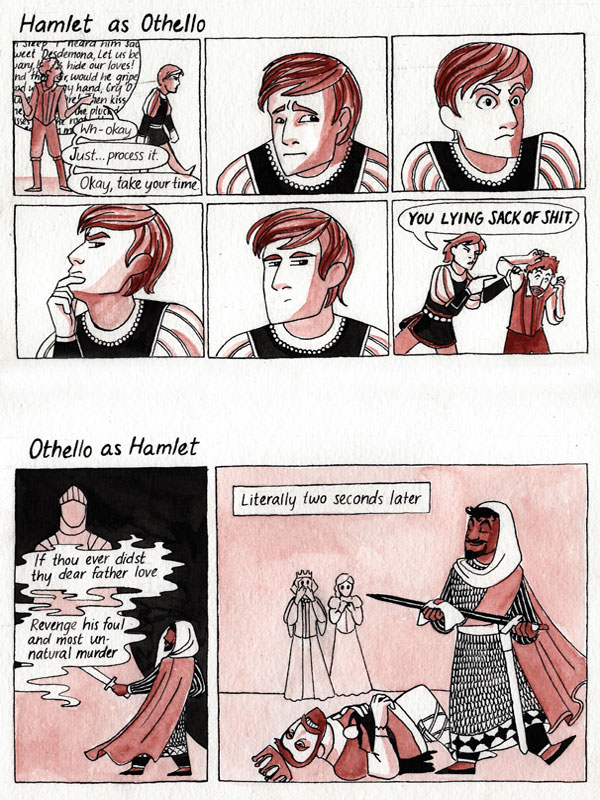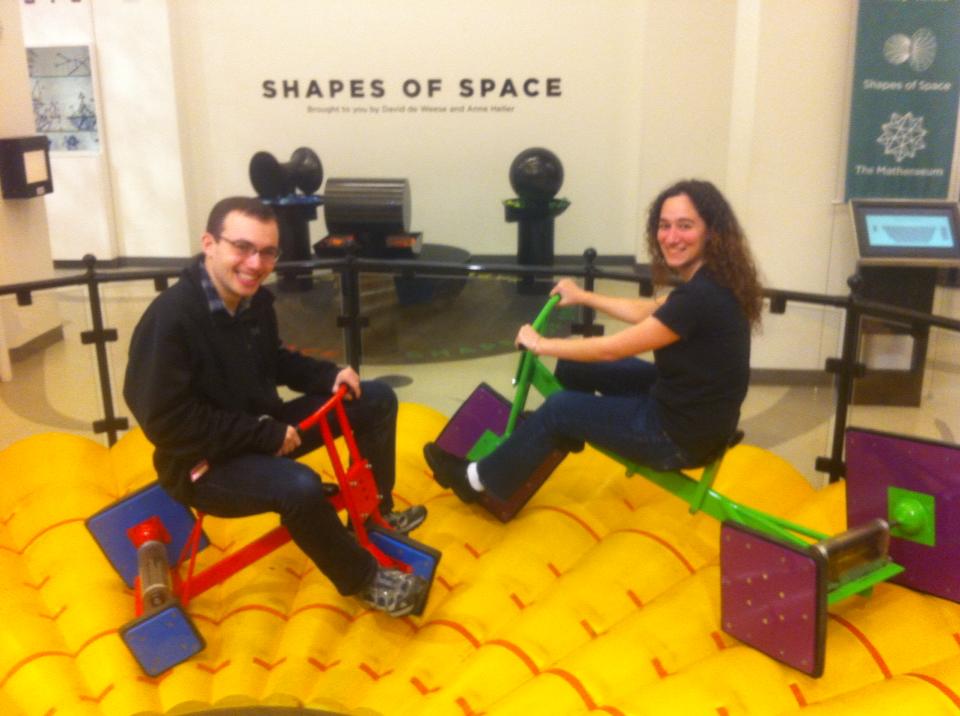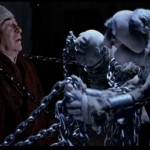Let’s start the Quick Takes with a link about beginnings. Keen envisions a better way to start players off in an MMO instead of dumping them all in the same newbie tutorial land.
Players start hours apart, and in areas of the world so different from each other that the social mechanisms are different. I remember seeing people say, “We do things differently in this part of the world.” Someone hunting in Crushbone might be used to players behaving differently than those in Blackburrow. Even the experiences are totally unique; Players on one side of the world might have a dungeon crawl deep into the depths of a vast cavern network, and players on the other side fight camps of orcs in a forest. The unique experience matters because people can swap stories.
(h/t Snarkmarket)
And speaking of transpositions and strange meetings, I adored this Shakespeare comic that points out “You know what they say! One man’s tragic flaw is another man’s pretty reasonable personality asset under the circumstances, I guess. Do…do they say that?”
There are more at the link, and I found these via Michael Blume.
If you are going adventuring yourself, you might be very tempted to visit the abandoned ruins of the Virginia Renaissance Faire, especially after seeing DCist’s slideshow, so allow me to pre-break your heart. Perhaps because of the new publicity, it is being vigilantly policed, and you will get caught tresspassing. I know this by rumor alone, and not because any of my friends were so caught and warned. Especially not to go play an original horror RPG on site. On Halloween.
Also beautiful and perilous, this ice-swathed lighthouse on the shores of Lake Michigan:
Believe you me, you want to see the rest of the pictures.
If your party of adventurers prefers less physically challenging settings for your derring-do, you might be interested in Cicada 3301, a mysterious online puzzle. The Telegraph has a nice feature, which begins as follows:
One evening in January last year, Joel Eriksson, a 34-year-old computer analyst from Uppsala in Sweden, was trawling the web, looking for distraction, when he came across a message on an internet forum. The message was in stark white type, against a black background.
“Hello,” it said. “We are looking for highly intelligent individuals. To find them, we have devised a test. There is a message hidden in this image. Find it, and it will lead you on the road to finding us. We look forward to meeting the few that will make it all the way through. Good luck.”
The message was signed: “3301”.
A self-confessed IT security “freak” and a skilled cryptographer, Eriksson’s interest was immediately piqued. This was – he knew – an example of digital steganography: the concealment of secret information within a digital file. Most often seen in conjunction with image files, a recipient who can work out the code – for example, to alter the colour of every 100th pixel – can retrieve an entirely different image from the randomised background “noise”…
Sleepily – it was late, and he had work in the morning – Eriksson thought he’d try his luck decoding the message from “3301”. After only a few minutes work he’d got somewhere: a reference to “Tiberius Claudius Caesar” and a line of meaningless letters. Joel deduced it might be an embedded “Caesar cipher” – an encryption technique named after Julius Caesar, who used it in private correspondence. It replaces characters by a letter a certain number of positions down the alphabet. As Claudius was the fourth emperor, it suggested “four” might be important – and lo, within minutes, Eriksson found another web address buried in the image’s code.
Feeling satisfied, he clicked the link.
It was a picture of a duck with the message: “Woops! Just decoys this way. Looks like you can’t guess how to get the message out.”
“If something is too easy or too routine, I quickly lose interest,” says Eriksson. “But it seemed like the challenge was a bit harder than a Caesar cipher after all. I was hooked.”
And while you’re feeling moved by math and crypto, perhaps you’d like to check out this interview with Edward Frenkel in the Economist? It finally tipped me over to putting his Love and Math: The Heart of Hidden Reality on my library hold list.
You describe math as “beautiful”. What do you mean?
Imagine you had an art class in which they taught you how to paint a fence, but never showed you the great masters. Of course, you would say; ‘I hate art.’ You were bad at painting the fence but you wouldn’t know what else there is to art. Unfortunately, that is exactly what happens with mathematics. What we study at school is a tiny little part of mathematics. I want people to discover the magic world of mathematics, almost like a parallel universe, that most of us aren’t aware even exists.
How did you discover it?
When I was growing up near Moscow I thought mathematics was the most boring and irrelevant subject, but I was fascinated with quantum physics and elementary particles. Luckily for me a professional mathematician was a friend of my family and when I was about 15 years old he said to me; ‘Do you know that this theory of elementary particles is based on mathematics?’ He showed me a book full of formulas and equations I could not understand, but I realised that these were glimpses of this magic world that was hidden from me and this was portal into that world. It was love at first sight. What professional mathematicians do goes to the heart of reality, to the heart of the universe. It’s what enables us to learn how the world works…
Symmetry exists without human beings to observe it. Does maths exist without human beings to observe it, like gravity? Or have we made it up in order to understand the physical world?
I argue, as others have done before me, that mathematical concepts and ideas exist objectively, outside of the physical world and outside of the world of consciousness. We mathematicians discover them and are able to connect to this hidden reality through our consciousness. If Leo Tolstoy had not lived we would never have known Anna Karenina. There is no reason to believe that another author would have written that same novel. However, if Pythagoras had not lived, someone else would have discovered exactly the same Pythagoras theorem. Moreover, that theorem means the same to us today as it meant to Pythagoras 2,500 years ago.
Yesterday, I spent several enjoyable hours at the Museum of Math. How much fun did I have, you ask? This much:
For more Quick Takes, visit Conversion Diary!
















